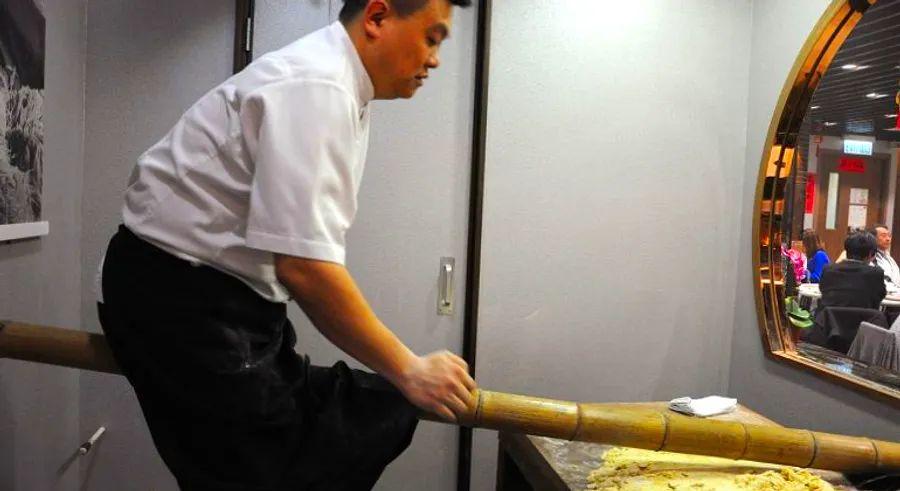Bouncing with one of Hong Kong's last bamboo noodle artisans

It’s as if he’s riding a seesaw, with Hong Kong’s noodle master Ken Lee balancing on a bamboo pole extending from a heavy wooden table.
The bamboo’s opposite end is attached to a massive rubber band, chained to the wall. A fresh batch of dough sits on the table, ready to be kneaded as Lee bounces on a low bench.
This is part of the unique process required to craft jook-sing noodles, a delicacy that’s becoming increasingly rare in Hong Kong.
Just a few skilled noodle masters still possess the knowledge to perform this technique.
“There are only about 10 jook-sing noodle masters left in Hong Kong today,” says Fei Wong, the third-generation owner of Wong Chi Kei.
Founded in Macau in 1946, Wong Chi Kei is one of Hong Kong's most beloved noodle spots. It’s also one of the few remaining restaurants that still makes its own jook-sing noodles. With locations in both Hong Kong and Macau, it serves nearly 2,000 bowls of noodles daily.
What makes jook-sing noodles truly unique?
Jook-sing noodles, or bamboo pole noodles, originated in the Canton region of China.
They are an essential, yet often overlooked, part of wonton noodles—one of Hong Kong’s signature dishes.
“Jook-sing noodles are made using eggs, flour, and a touch of alkaline water,” says noodle master Lee, the executive chef at Wong Chi Kei and cousin of owner Fei Wong.
“What sets them apart is the use of the bamboo stick. By pounding the dough in this way, it develops gluten, giving the noodles a refreshing, firm texture,” says Lee, who has been perfecting the craft for over 20 years.
All of Wong Chi Kei’s noodles are now made in Macau, but their Hong Kong Causeway Bay location has a noodle room used for occasional workshops and performances.
According to Lee, most of the noodles sold in Hong Kong today are made entirely by machines, skipping the bamboo-kneading technique.
“They rely heavily on adding alkaline water to create an al dente texture, but this results in a distinct, unpleasant smell,” he adds.
“We use our hands and bamboo poles to craft the noodles. You can immediately feel the difference,”
Why bamboo? This incredibly versatile plant is valued for its flexibility and strength, making it the ideal tool to generate the immense force needed for the kneading process.
The bamboo pole currently used at the Causeway Bay Wong Chi Kei has been in service for over ten years. The wooden table, custom-built and firmly nailed to the floor, shows signs of its long history, with a subtle dip worn into its surface from years of bamboo beating.
Just keep bouncing.
“The biggest challenge in preserving this traditional craft is the lack of skilled talent in the industry,” says Wong.
“The repetitive and physically intense nature of the work has discouraged many young people from entering the industry, and the Chinese culinary field as a whole,”
“My uncle, a bridge engineer, has been studying the physics and mechanics of jook-sing noodles in the hopes of creating a machine that can replicate the traditional bamboo-beating process,”
But some things are still beyond the reach of machines. Lee stops to check the dough, feeling it with his hands.
“You have to feel it yourself,” he explains. “If the dough isn’t right, we keep going, bouncing on it until it’s perfect.”
He folds the dough, returns to his position, and resumes bouncing on the bamboo pole.
“The more you practice, the better you’ll understand how to make the noodles, adjusting for humidity and weather. This isn’t something anyone can teach you – you have to figure it out on your own. It took me six to seven years to truly master it,”
Weight plays a crucial role in the traditional technique.
“The heavier you are, the less energy you need,” says Wong. “But my grandfather (the founder) only weighed 120 pounds. When he worked the bamboo, he had to leap high on one foot, almost like he was performing kung fu.”

When the dough is ready, it’s fed into a machine to be flattened and cut into thin noodles. As a teenager, Wong spent his summers learning the art of making jook-sing noodles – a skill passed down through his family.
“I performed the noodle-making process at the Causeway Bay branch when I first rejoined the family business,” says Wong.
“It didn’t take long before I had a sore bum – I had gotten out of practice.”
Continuing the legacy
Wong, who leads the company’s business development, is always on the lookout for ways to modernize and innovate the business.
For example, in recent years, Wong Chi Kei has started offering dried jook-sing noodles, branded as Yea Yea Noodles (or Grandpa Noodles), as souvenirs and gifts. The goal is that the modern packaging will appeal to a wider audience and help grow the noodles' fanbase.
“Wong Chi Kei has been serving three generations of customers – it’s something that means a great deal to me,” says Wong.
“My grandfather spent decades perfecting the noodles. I aim to carry on his legacy and continually improve the recipe. In Japan, there are family-run businesses that have lasted eight generations – that’s 300 years of history.”
“Building a business that lasts for generations is no easy feat, but if we can create a legacy like that, it will become a treasured heritage in the food and beverage industry.”
Wong Chi Kei, Way On Commercial Building, 500 Jaffe Road, Causeway Bay; Open daily from 11 a.m. to 10:30 p.m.

1
2

3

4

5
Evaluation :
5/5